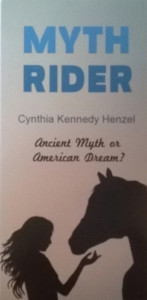As I finish up edits on MYTH RIDER, my new historical middle grade novel coming from 4RV Publishing, I feel like I’m having constant anxiety attacks. The manuscript has been through a critique group. It has been through editors. I’ve read and reread. Finally, FINALLY I think it is done — then I see on the last read that the main character just put her feet in the saddle while she was riding bareback. How did I miss that the last fifteen times I read it?
Continuity, making sure that your story moves through time and space in a logical fashion, is difficult. I write in fits and starts. I change things. I add things. I delete things. I know more about my characters, the setting, and the history surrounding the story than I can include. I have learned to use a few tools to make keeping my little world in line easier.
Timelines. Stories span hours, days, sometimes even years. I always make a timeline and put major events on it, including weather events and holidays. This lets me tell the hour or day at a glance. I don’t want a character talking about a crime that hasn’t been committed or being soaking wet in the morning when the rain starts after noon. If my character is at a mall, I want to see shamrocks or Easter eggs in March. Also, how much time does it take to do a task or travel from place to place? It can’t take an hour to get to school one day and ten minutes the next without an explanation. Your character won’t grab a sweater on a hot July day. At 7:00 pm in winter they may need a flashlight as they run through the woods, but likely not in summer.
Maps. Continuity is also about setting. Rooms have furniture, and it seldom moves. Doors go somewhere, like onto a porch or into the kitchen, quite consistently. Paths and streets aren’t straight one day then offer convenient bends to run around the next. Backyards have fences, or not. I draw rough maps of rooms, areas, towns, etc. that I add to while writing to give me a visible picture of where things are.
Objects. Authors must keep track of objects that appear, or are notably absent, in a story. How are the brambles scratching her bare legs when she is wearing jeans? What happened to that ice cream cone she was licking before she grabbed the dog? Do they have objects they see? Why is she wondering about the time when there was a big clock on the wall yesterday? I understand having a knife in the kitchen, but why does he have one in the bedroom? I try to plant objects that will be relevant to the story early. If my character will need a heavy object to break the window, I put it there before he needs it. Finally, I try to visualize scenes as if they were in a movie — ready to call costume or props if something is awry.
Outline. The most critical element of continuity is plot. I generally don’t outline before I write, but I do outline once I have a draft. It helps me write a synopsis; that one-page summary that someone is sure to ask for. It makes me think through the plot elements to see if they are logical, can be rearranged, or if scenes can be added or deleted without breaking the flow. In longer works, I do two outlines. One is a general outline, the other is a chapter outline with each scene listed.
Timelines, maps, visualization, and outlines all help keep your world in order.

I love this blog! So often I see little errors such as these in books I’ve read. But, yes, it is so hard to keep things straight when writing, because, as you said, we do not write the whole book in one sitting. Although in my book the stories are true, I have run into similar problems. The stepparents I’ve interviewed are anonymous in my book, so, consequently, I’ve had to make-up names for them. However, I’ve changed their names from time to time for various reasons. Because of this, I have found that the stepparent has had two different names in the same story. This, of course, freaked me out, making me realize that I had to go through every single story to make sure that the names all matched up. Ugh! That was a lot of work! Good luck with your book! I’m sure you will get it all straight! 🙂